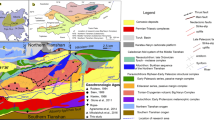Abstract
In the Rogaland–Vest Agder terrain of the Sveconorwegian Province of SW Norway, two main Sveconorwegian metamorphic phases are reported: a phase of regional metamorphism linked to orogenic thickening (M1) and a phase of low-pressure thermal metamorphism associated with the intrusion of the 931 ± 2 Ma anorthosite-charnockite Rogaland igneous complex (M2). Phase M1 reached granulite facies to the west of the terrane and M2 culminated locally at 800–850 °C with the formation of dry osumilite-bearing mineral associations. Monazite and titanite U-Pb geochronology was conducted on 17 amphibolite- to granulite-facies orthogneiss samples, mainly from a suite of 1050 +2/−8 Ma calc-alkaline augen gneisses, the Feda suite. In these rocks, prograde negatively discordant monazite crystallized during breakdown of allanite and titanite in upper amphibolite facies at 1012–1006 Ma. In the Feda suite and other charnockitic gneisses, concordant to slightly discordant monazite at 1024–997 Ma probably reflects breakdown of biotite during granulite-facies M1 metamorphism. A spread of monazite ages down to 970 Ma in biotite ± hornblende samples possibly corresponds to the waning stage of this first event. In the Feda suite, a well defined monazite growth episode at 930–925 Ma in the amphibolite-facies domain corresponds to major clinopyroxene formation at the expense of hornblende during M2. Growth or resetting of monazite was extremely limited during this phase in the granulite-facies domain, up to the direct vicinity of the anorthosite complex. The M2 event was shortly followed by cooling through ca. 610 °C as indicated by tightly grouped U-Pb ages of accessory titanite and titanite relict inclusions at 918 ± 2 Ma over the entire region. A last generation of U-poor monazite formed during regional cooling below 610 °C, in hornblende-rich samples at 912–904 Ma. This study suggests: (1) that monazite formed during the prograde path of high-grade metamorphism may be preserved; (2) that monazite ages reflect primary or secondary growth of monazite linked to metamorphic reactions involving redistribution of REEs and Th, and/or fluid mobilisation; (3) that the U-Pb system in monazite is not affected by thermal events up to 800–850 °C, provided that conditions were dry during metamorphism.
Similar content being viewed by others
Author information
Authors and Affiliations
Additional information
Received: 9 January 1997 / Accepted: 15 April 1998
Rights and permissions
About this article
Cite this article
Bingen, B., van Breemen, O. U-Pb monazite ages in amphibolite- to granulite-facies orthogneiss reflect hydrous mineral breakdown reactions: Sveconorwegian Province of SW Norway. Contrib Mineral Petrol 132, 336–353 (1998). https://doi.org/10.1007/s004100050428
Issue Date:
DOI: https://doi.org/10.1007/s004100050428




